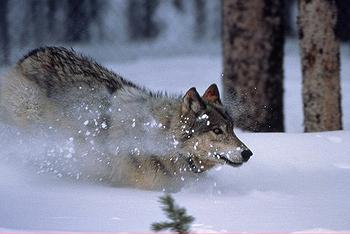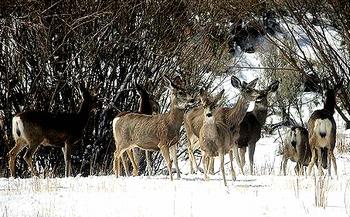Loss of Northern Hemisphere Carnivores Distresses Ecosystems
CORVALLIS, Oregon, April 9, 2012 (ENS) - Across the Northern Hemisphere, populations of moose, deer, and other large herbivores now far exceed their historic levels and are disrupting ecosystems, finds a new survey on the loss of large predators, particularly wolves.
"The preservation or recovery of large predators may represent an important conservation need for helping to maintain the resiliency of northern forest ecosystems, especially in the face of a rapidly changing climate," conclude the survey authors from Oregon State University.
 |
A gray wolf in Yellowstone National Park. (Photo courtesy Yellowstone National Park) |
"These issues do not just affect the United States and a few national parks," said William Ripple, an Oregon State University professor of forestry and lead author of the study. "The data from Canada, Alaska, the Yukon, Northern Europe and Asia are all showing similar results."
"There's consistent evidence that large predators help keep populations of large herbivores in check, with positive effects on ecosystem health," said Ripple.
After examining 42 studies conducted over the past 50 years, the scientists found that herbivore densities are nearly six times greater in areas without wolves as compared to areas with wolves.
The increased populations of moose, deer and other herbivores are crippling the growth of young trees and reducing biodiversity, the Oregon State study concludes. This contributes to deforestation and results in less carbon sequestration, a potential concern with climate change, the researchers said.
Large predators can help maintain native plant communities by keeping large herbivore densities in check, allowing small trees to survive and grow, reducing stream bank erosion, and contributing to the health of forests, streams, fisheries and other wildlife.
 |
Bears in a Finland forest (Photo by Grete Howard) |
The new analysis makes clear that the potential beneficial ecosystem effects of large predators is far more pervasive, over much larger areas, than has been appreciated.
The research results apply to Idaho and Montana, where hundreds of wolves are being killed to reduce ranching conflicts and increase game herd levels, but they apply across the entire Northern Hemisphere as well.
The researchers also found that combinations of predators, such as wolves and bears, "can create an important synergy for moderating the size of large herbivore populations."
"Wolves can provide food that bears scavenge, helping to maintain a healthy bear population," said Robert Beschta, a professor emeritus at Oregon State and co-author of the study. "The bears then often prey on young moose, deer or elk - inYellowstone more young elk calves are killed by bears than by wolves, coyotes and cougars combined."
In Europe, the coexistence of wolves with lynx has also resulted in lower deer densities than when wolves existed alone.
This research survey was published online today in the "European Journal of Wildlife Research."
 |
Herd of wild deer near Oakley, Idaho (Photo by Darren Peterson) |
Oregon State researchers focused on understanding how major predators help to reduce herbivore population levels, improve ecosystem function and even change how herbivores behave when they feel threatened by predation - an aspect they call the "ecology of fear."
"In systems where large predators remain, they appear to have a major role in sustaining the diversity and productivity of native plant communities, thus maintaining healthy ecosystems," said Beschta. "When the role of major predators is more fully appreciated, it may allow managers to reconsider some of their assumptions about the management of wildlife."
The survey concludes that human hunting is not effective in preventing hyper-abundant densities of large herbivores, "because hunting by humans is often not functionally equivalent to predation by large, wide-ranging carnivores such as wolves."
"These findings have important conservation implications involving not only the management of large carnivores, but also that of large herbivores and plant communities," the authors write.
"More studies are necessary to understand how many wolves are needed in managed ecosystems," Ripple said. "It is likely that wolves need to be maintained at sufficient densities before we see their resulting effects on ecosystems."
Copyright Environment News Service (ENS) 2012. All rights reserved.